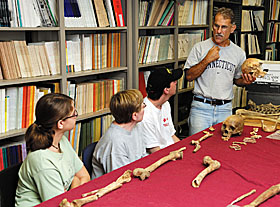  |
| HOME | THIS ISSUE | CALENDAR | GRANTS | BACK ISSUES | < BACK | NEXT > |
Archaeology enthusiasts learn basics at new field schoolby Kala Kachmar - July 23, 2007 | ||||
| After years of sifting through dirt and rocks in her own backyard, Carolyn Read-Burns has been able to put her skills to use this summer in a formal archaeological dig. Read-Burns was one of the participants in UConn’s first archaeological field school for adults, which gave her the opportunity to dig at a 3,000 to 4,000-year-old Native American encampment in Connecticut. The five-day field school was organized by the Connecticut State Museum of Natural History and Connecticut Archaeology Center, part of UConn’s College of Liberal Arts and Sciences. “This was an opportunity for people to partake in an important archaeological research project in our backyard,” says Nick Bellantoni, the State Archaeologist, who led the field school. “Hopefully what we found will be helpful in uncovering Connecticut’s past.” Read-Burns, a member of Lisbon’s historic society, has previously helped uncover artifacts near the historic Bishop House in her hometown. “When I first learned about the field school, I jumped at the opportunity,” she says. “I thought I would finesse what I’d already learned.” Not all the participants in the field school had previous experience. The purpose of the school is to teach interested adults the basics. The first day served as a training session. Participants learned about the cultural, legal, and theoretical aspects of archaeology, as well as what to expect in the field. Three of the five days were spent in the field. One day was spent in the lab, cataloging items and learning how to determine the gender, age, and lifestyle of humans by looking at their bones. “We want people to get not only the excitement from this experience, but to understand that it’s work too,” Bellantoni says. “It’s exciting when someone finds something that hasn’t been seen in 1,000 years or longer.” Each student was responsible for a 25-square-foot grid of earth. They were provided with hand tools, including trowels, brushes, and bamboo picks, which they used to slice and scrape the earth level, one centimeter at a time, in a way that allowed for artifacts to be recorded in place.
Understanding the association of the objects with the place they are found is crucial, Bellantoni says. “An artifact alone doesn’t tell us a lot of information,” he says. “Artifacts are material culture. They are nothing more than manifestations of our technology, morals, and beliefs, all which reflect our behavior. We take all the artifacts from a site together with their location and try to interpret human behavior.” Sam Lee, a high school student who hopes to be an archaeologist in the future, found a wet stone polishing tool and a piece of stone jewelry on his first day digging. “This experience has made me want to do it more,” Lee says. “It also taught me how to be patient.” Another participant, Herb Davidson of Somers didn’t have to dig deep before encountering an artifact. He found a quartz flake, the byproduct of a tool that was made long ago. “There’s a lot to discover about the past underneath the earth’s surface,” he says. Although some other institutions offer archaeology field schools, most are longer than UConn’s, making it difficult for the general public to participate, according to Bellantoni. Participants came from all over the east coast, and as far south as Virginia. “People in this area will no longer have to travel to the southwest United States, Mexico, or Europe to take part in a dig,” he says. The Connecticut Archaeology Center also offers field schools for children. “We’ve long been involved in doing this for children and students,” says David Colberg, public information coordinator for the Connecticut State Museum of Natural History. “The adult field school is an offshoot of that – it’s a chance to let adults play in the dirt.” |
| ADVANCE HOME UCONN HOME |

